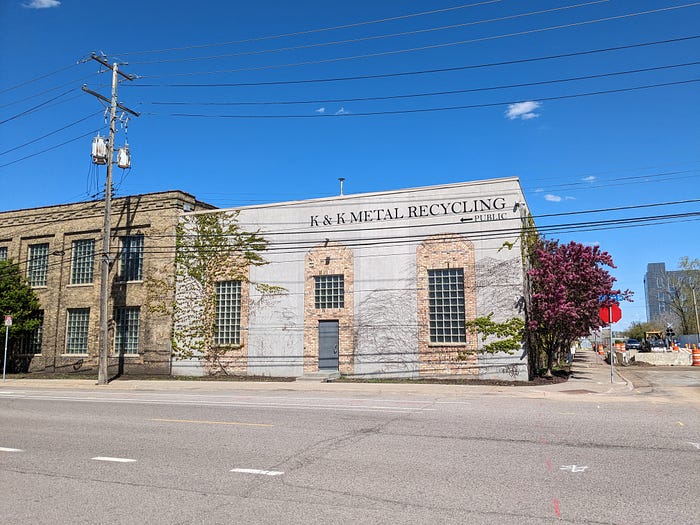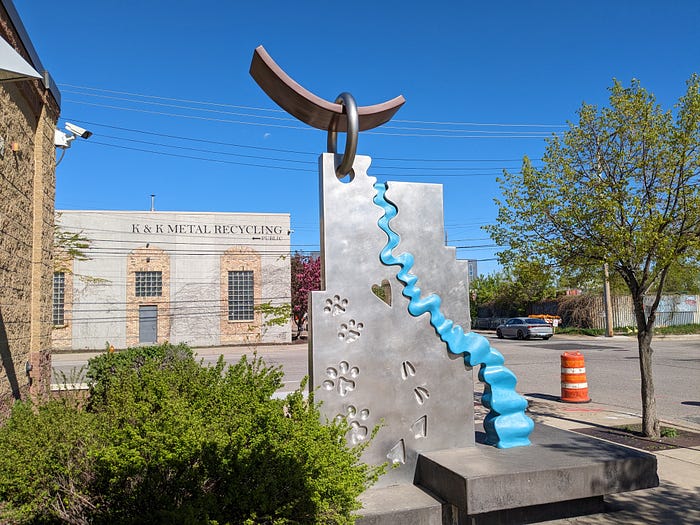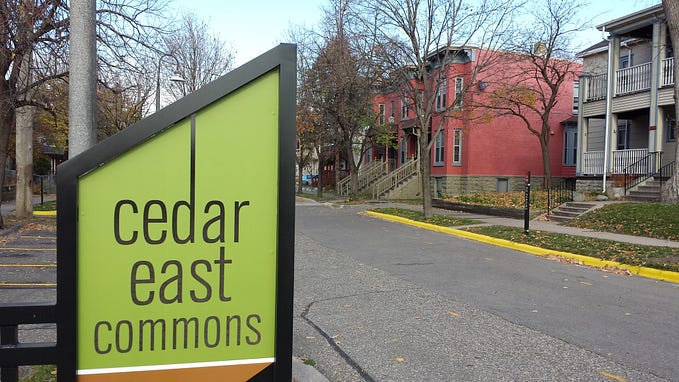In Near North, Industry Meets a Suburb in the City
Whereas my previous visit to Near North focused on a late 19th century residential area, this time in the northeastern portion of the neighborhood I found two distinct areas juxtaposed: industry along the river, and a residential “suburb in the city” constructed in the 1970s.
On my route map, you can see the suburban style development to the west of I-94 as the curving cul-de-sacs that branch into further cul-de-sacs. These are among the spurs that I walked forward and back and so are shown in red on the map. In the industrial area to the east of the interstate, there are some more linear spurs, which were in part necessitated by road construction. There’s also a two-block loop in blue connected to the main loop only by spurs.
So far as the main loop goes, the starting and ending point for that is on the northern edge of the neighborhood, West Broadway, at Second Street North. There, across the street from the Northside Achievement Zone, I saw the first of several artistically wrapped traffic control cabinets.

This industrial area has many ages of buildings, but the earliest date back to the 19th century. An example from my spur south on Washington Avenue is the one that now contains Bar Brava. Judging by the building permit index, it started life as a store with residences above and went through various other uses, including a saloon and a factory. Maybe the saloon counted as a store? The ghost sign suggests a cafe serving Coca-Cola.

The present-day uses of the industrial area range from true industry to storage, the arts, hospitality, and education. One of the larger categories is metal recycling, which has been a recurrent source of conflict. None of that conflict was visible on my walk, however. Instead, I saw multiple metal recycling facilities, just as I saw multiple storage facilities.


Once I crossed over the interstate on West Broadway, I was on the commercial thoroughfare just north of the residential area. I’d devoted enough attention previously to this road that I only came away with one more photograph, another wrapped traffic control cabinet. On the north side of the street, there’s an important new mural, All Seasons, by Charles Caldwell, but that’s in the Hawthorne neighborhood rather than Near North.

Turning south on a half-block-long section of 5th Street North, I got a first good view of one of the townhome collections that provides a higher-density adjunct to the cul-de-sacs of detached single-family homes. And then around the corner, the Lyndale Manor public housing for seniors further illustrated the diversity of housing options.


In common parlance, “Lyn Park” is used for the all of the suburban-style development, of which Lyn Park Circle is a prime example. North News published a good profile of the area in context of recent activism that successfully rerouted the Blue Line Extension.

I always try to keep my eyes open when I’m walking because not everything fits into a neat category like “housing styles” or “public art.” Some sights are even more ephemeral than the trees in blossom. For example, I must have gotten the timing just right to see a tree with a full-circle skirt of shadow.

For automobiles, the suburban-style development is divided into two distinct pieces, one north of Hall Park and the other south. However, pedestrians have the luxury of trails connecting the park to Lyn Park Avenue and Lyn Curve Avenue on the north side and Hall Lane on the south. I used one of these to access the park from Lyn Curve.
When I last visited Hall Park, the portion east of Lyndale Avenue was closed for renovations, which included in particular the construction of a bicycle skills course. Now I was able to see the fruits of that project, including work by Juxtaposition Arts and Melodee Strong.




After exiting the park onto Lyndale, I briefly detoured west of that avenue in order to pick up a few blocks I had omitted from my prior walk. (Together with an earlier spur on West Broadway, these were the only exceptions to Lyndale’s status as the boundary between the two walks.)
This area between Lyndale and Aldrich Avenues continues the same combination of suburban-style cul-de-sacs and townhome development as east of Lyndale. Rather than photograph more of the housing, I prioritized another flowering tree. A walk in May has its particular pleasures.

Back on the east side of Lyndale, but south of Hall Park, I walked Hall Curve with Hall Lane and Harry Davis Lane branching off of it. The latter fits a pattern more pronounced on the west side of Lyndale, the naming of cul-de-sacs for prominent Black figures in local history. One good starting point regarding Davis’s life is Lorna Benson’s MPR obituary of him. (Of the western examples, the only one I walked this time was named for Van White.)

After crossing back over the interstate on Plymouth Avenue, industrial buildings of varying ages again became dominant, starting with a classic 1925 example on the northeast corner with 3rd Street North. At the left of the photo, you can just see that the building has had more recent additions.

From 3rd Street, I used Washington Avenue to access the little loop between 16th and 18th Avenues. In particular, I was walking eastbound on 18th Avenue when I first caught sight of the West River Arts Building from its rear.
As is apparent from the photo, this building has two distinct parts. Based on building permit index entries, they date from 1906 and 1946. As on many street corners, the older building started out as a mixed retail/residential building (two stores and a rooming house). But from 1926, it housed Stewart Paint’s office and manufacturing facility, which then spread into the newer building.


Among the arts building’s current tenants, the most prominent is Dame Errant Clay on the ground floor of the older building. Dame errant provides adults with workshops focusing on “creativity as self care” with the staff then doing the firing and glazing. Some of the creations are available for purchase in a retail area at the front of the studio.


The physical appearance of the K&K Metal Recycling building across the street made more sense once I realized it had been the Diamond Iron Works. So that explains the prominent diamond-shaped brickwork above the main entrance. I was also interested to see from a 1941 newspaper photo that the diamond motif was also incorporated in the windows.

The newer addition on the south end of the building stands out principally because of the brick insets into its precast concrete facade — I don’t recall having seen that technique before.

Back on the west side of the street, the industrial-park–style building to the south of the West River Arts Building would not have attracted my attention were it not for the banners on its front promoting drama, voice, and dance. Only in that way did I learn of Lundstrum Performing Arts, an important part of the community since its founding by a 15-year-old in 1927.
This is far from the first time I’ve learned of a nonprofit organization only by stumbling across its headquarters, but it always is equal parts exciting and embarrassing. Excitement at learning something new, embarrassment that I was paying less attention to their achievements than to their brick and mortar.

I left 17th Avenue North for later, when I would walk it as a long spur off of West River Road. The remainder of the area between Lundstrum Performing Arts and Plymouth Avenue was partially off limits due to road construction on 2nd Street North, but I poked my way through it as best I could using various spurs.
Once back to Plymouth, I continued out over the river on the bridge, which provided a good vantage point to see the parkway trails that run betwen West River Road and the river. The large, modern, blue building in the distance is the US headquarters of Coloplast, an international maker of products for ostomy care and the like.

Heading north from Plymouth on West River Road, I would have to pass a couple industrial buildings before I got to Coloplast, and the very first of them was a stopping point for me — Pryes Brewing.

Once I was on the 17th Avenue spur, I was able to get a closer view of K&K Metal Recycling, which I had previously only seen from across 2nd Street. In my earlier photo of the new addition, you may have seen a colorful flowering tree on the south side. Now I got to see the individual blossoms. More generally, I was quite impressed at the care this metal recycler took with beautifying its property.

Continuing to the west, the building on the far side of 2nd Street is the Minneapolis Animal Care & Control Center. The sculpture out front, Heart of the City by Caprice Glaser (2004), was recognizable to me as an approximation of the outline of Minneapolis with the Mississippi running through it. But there were several other elements of the design that escaped me entirely until I read about it. Maybe you’ll do better than me.

After returning to the river, I appreciated the beautiful day a bit more and completed my circuit by returning to the Northside Achievement Zone, where the north side of the building features a mural by Reggie LeFlore.












